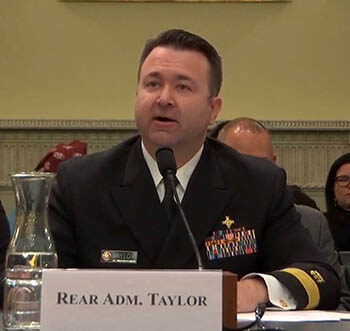 Rear Admiral Brandon Taylor of the U.S. Public Health Service Commissioned Corps, the director of DHA Public Health, testifies at a hearing. (Courtesy Photo)
Rear Admiral Brandon Taylor of the U.S. Public Health Service Commissioned Corps, the director of DHA Public Health, testifies at a hearing. (Courtesy Photo)
MHS Communications: How does Public Health prevent diseases and their spread and what is the next thing to look for?
Rear Adm. Taylor: It is the collective goal of the public health enterprise to detect and assess disease threats to our services before their exposures and to prevent diseases from negatively affecting their health and the mission. DHA intends to continue enhancing integrated biosurveillance and coordinating with our DOD mission partners to provide early detection and warning of potential threats in the operational environment as well as at our garrison locations.
For example, DHA Public Health will continue conducting surveillance and performing whole genome sequencing of respiratory viruses causing influenza-like illness on samples collected globally to identify emerging/re-emerging viruses or public health events of concern that could impact military operations and threaten our forces. These include SARS-CoV-2 variants and seasonal influenza.
The Electronic Surveillance System for the Early Notification of Community-based Epidemics, known as ESSENCE, is a critical tool to help the public health enterprise identify emerging, new or novel diseases that threaten to enter the MHS facilities around the world. The DOD coordinates closely to share ESSENCE information that captures disease threats as early as possible in their evolution.
The next step in the evolution of biosurveillance is to explore forecasting and predictive analytic platforms providing even earlier detection capabilities to public health leaders. Additionally, public health leaders are exploring comprehensive notification capabilities that could assist in preventing the spread to our military family.
MHS Communications: How does Public Health factor into Total Force Fitness?
Rear Adm. Taylor: We play a significant role in Total Force Fitness as the public health principles of "health promotion" and "disease prevention" have great implications for TFF. For example, public health teams recently reported the results of monitoring for heat-related injuries at the Army installation in Aberdeen, Maryland. Everything we do in DHA Public Health is to benefit and improve the total fitness of the force to ensure they are protected, ready, and fit to fight.
MHS Communications: It is interesting that you deployed on numerous missions. Could you briefly discuss why that was important to you?
Rear Adm. Taylor: Most U.S. Public Health Service officers cite the opportunity to deploy as one of the primary reasons they commission. This was the case for me as well. I suspect each of us feel compelled to be of service to people of need, to be a part of something bigger than ourselves, whether it be in the provision of direct patient care, engineering and environmental health services, case management, patient movement, or leadership.
For me, each deployment was an opportunity to answer the call to serve, help, contribute, lift, and lead. Each deployment experience stretched me physically, emotionally, socially, and even spiritually. As a result, each deployment helped me grow as an officer and person. Will Rogers said: "Even if you're on the right track, you'll get run over if you just sit there." Meaningful and intentional growth are important to me. I seek for it even today and have sought for it most of my career.
MHS Communications: Where did your interest in pharmacy come from?
William "Bill" Medlin was a family friend, and as a youth, we attended the same church in Elizabeth City, North Carolina. I really looked up to him as a grandfather figure, a man of faith, and a professional with keen knowledge and wisdom. When I learned of his profession, I shadowed him in his community pharmacy for a month as part of a high school program. I saw how he interacted with his patients and the community, and he embodied leadership, care, and compassion to me. Seeing how the community looked to him for his sincerity, concern, and knowledge as their pharmacist, I wanted to be like him and serve like him.
MHS Communications: Does it relate to your serving underserved populations who may have more mental health and other health issues?
Rear Adm. Taylor: It mostly relates to my mother's love for others through health care and my father's passion for uniformed service and love of country.
My mother served as a physical therapy assistant and provided direct patient care in home health for many years. Her one-on-one care taught me the importance of caring for the one. My father's service as a master sergeant in the United States Army Special Forces taught me service before self and how to love and serve my country.
While in pharmacy school at Campbell University in North Carolina, I learned more about my family's American Indian roots and family history through my father and uncle. As I learned more about my heritage and ties to the Cherokee Nation and Seneca Cayuga Nation, both in Oklahoma, I was fascinated and drawn to serve my extended family there as a uniformed officer and pharmacist.
I remember being overwhelmed with a sense of belonging after I interviewed for my first position within the Cherokee Nation jurisdiction. I knew I was meant to serve American Indians and Alaska Natives at that time. What ensued was a culturally rich, beautiful, professionally fulfilling, and personally influential experience that would impact my entire family and career path.